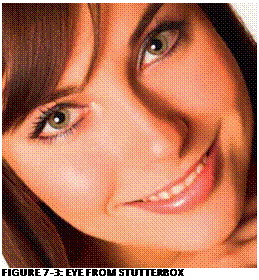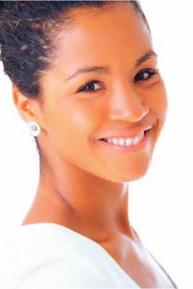1. ![]()
![]()
 Begin with a foundation primer and any eye shadow primer. Apply with a
Begin with a foundation primer and any eye shadow primer. Apply with a
![]() sponge. Areas of the face have uneven oil distribution, and will accept and hold foundations irregularly. A primer will have moisturizing effects in that it retards water evaporation from cells, and will create a more even surface for foundations and color cosmetics.
sponge. Areas of the face have uneven oil distribution, and will accept and hold foundations irregularly. A primer will have moisturizing effects in that it retards water evaporation from cells, and will create a more even surface for foundations and color cosmetics.
2. Liquid or oil foundation applied with a foundation brush. To keep a more natural look to the skin’s surface, use foundation sparingly, do spot coverage (spot painting), and add pinker tones to the foundation with cream rouges as they naturally occur in the skin.
3. Cheeks are typically a bluish pink, never brown. Think blood vessels, the source of color. For a natural cheek, drag cream blusher down slightly toward the jawline and add a touch to the bridge (not tip) of the nose. This may be very subtle or quite heavy, depending on the situation. Example: to approximate the palest Irish skin with flushed cheek.
4. Powder with a yellow-based powder, then add powdered blush on the surface. The pink-yellow-red layer imparts a sense of depth, and therefore reality, to the foundation’s finish. As the day progresses, try to blot before adding more powder. Remove as much natural oil as possible with blotting paper. Natural oil production plus powder creates another layer of a kind of foundation that gets heavier throughout the day if never blotted.
5. I use eyelashes for character effect.
In beauty makeup, the amount of attention brought to the eyes and eyebrows will depend on character and situation. There is a range to work from, but save the “smoky eye” for the glamour makeups that are more stylistic and dramatic.
Practice eye treatment and combinations of colors with as many models with varieties of eye color and shape as possible. Your eye and hand need the practical experience to develop your talent. You need to make mistakes as well as get it right to have the ability to deal with the uniqueness of each person.
Practice the art of eye shadow. Start with applying an eye shadow primer all over the lid. Try Paula Dorf. This preps the eyelid, helps the shadow last, and gives a smooth finish for eye shadow application. Using an eye shadow brush, apply a base color of shadow in cream, pink, beiges, all over the lid. Next, define the eye structure by applying browns or grays or blues in the eye crease. Placement is key, color choice is open to what looks good on the person.
Start with browns until you have mastered placement. Have your model look in the mirror to check and correct placement. This is “working off the mirror.” You will do this to correct and check your work in all situations. Does the eye look open and balanced, or drooped? Is there enough definition? Is the application smooth and consistent in color, or muddy? Is there too much color in the inside corner? Too much of a straight line in the crease? Take photos to critique placement and style.
 changing eyebrows is a great tool in character design and altering a look. The level of intensity and style of the brows will come from the character or situation. Brows should have a natural, unpainted look when doing a “beauty look” or “natural look.” Glamour makeup has all the drama, with a precise shape to the eyebrow that is obviously drawn or painted on. There are several ways to shape brows using different products: brow pencil, brow creams or shadow, eye shadow, temporary hair color, Stacolor or Reel Color.
changing eyebrows is a great tool in character design and altering a look. The level of intensity and style of the brows will come from the character or situation. Brows should have a natural, unpainted look when doing a “beauty look” or “natural look.” Glamour makeup has all the drama, with a precise shape to the eyebrow that is obviously drawn or painted on. There are several ways to shape brows using different products: brow pencil, brow creams or shadow, eye shadow, temporary hair color, Stacolor or Reel Color.
Choose colors that are close in shade to the eyebrow or slightly lighter. Remember, browns photograph darker. For a realistic brow, use two colors, to fill in or shape.
![]()

|
|
|
|
|

![]()

